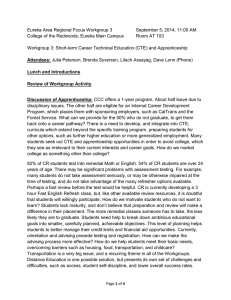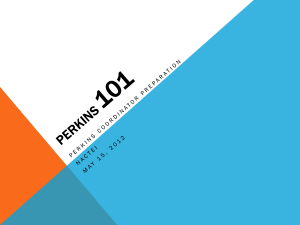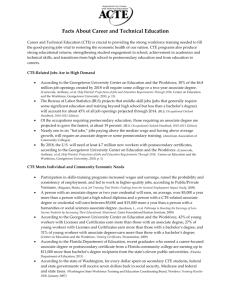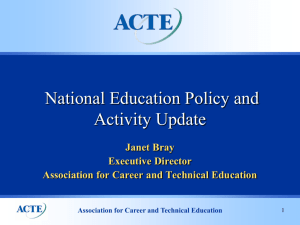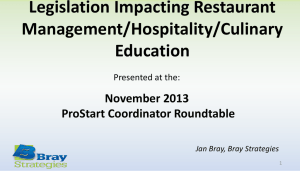U.S. Vocational Education System
advertisement
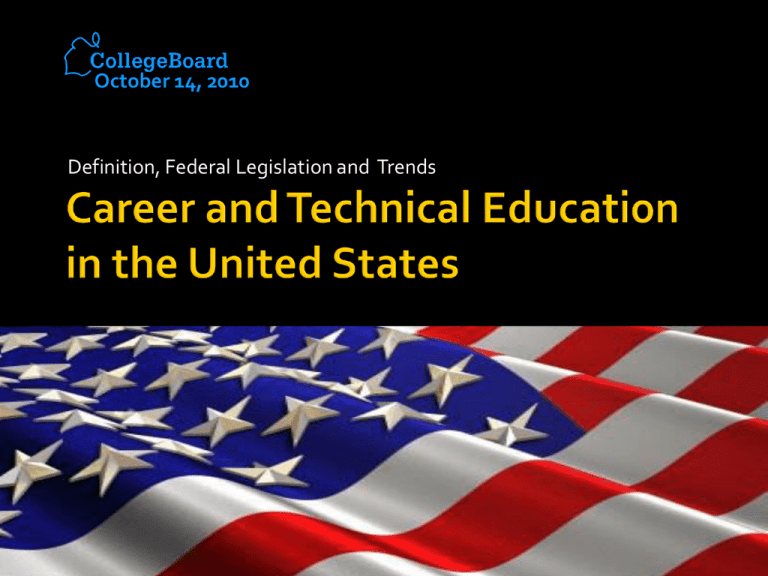
October 14, 2010 Definition, Federal Legislation and Trends Vocational Education – “training for a specific vocation in industry or agriculture or trade” (Webster, 1993). Career and Technical Education (CTE) – “provides technical knowledge and skills aligned with academic standards that are needed to prepare for further education and careers in current or emerging professions” (2006 Carl D. Perkins Career and Technical Education Improvement Act). The U.S. workforce development system consists of several dozen programs or funding streams that are funded at about $20 billion. These funds are administered by 15 federal departments and independent agencies, but the majority are located in: U.S. Department of Labor U.S. Department of Education, or U.S. Department of Health and Human Services American Recovery and Reinvestment Act of 2009 (a.k.a., Stimulus) A direct response to the economic crisis, the Recovery Act has three immediate goals: Create new jobs and save existing ones Spur economic activity and invest in long-term growth Foster unprecedented levels of accountability and transparency in government spending The Recovery Act intends to achieve those goals by: Providing $288 billion in tax cuts and benefits for millions of working families and businesses Increasing federal funds for education and health care as well as entitlement programs (such as extending unemployment benefits) by $224 billion Making $275 billion available for federal contracts, grants and loans Workforce Investment Act of 1998 Administered by U.S. Dept of Labor, Employment and Training Administration (ETA) Consolidated about 40 Labor Department job training programs (e.g., JTPA, Job Corps, Adult Basic Education, etc.) Provides an overall structure for the nation’s workforce development system Established business-led workforce investment boards (WIBS) Provides one-stops-centers in every state to help users navigate the federal job-training maze The National Apprenticeship Act of 1937 Administered by U.S. Dept. of Labor, Employment and Training Administration (ETA), Office of Apprenticeship Provides a national system for skilled and technical occupational training, which promotes apprentices, registers apprenticeship programs, certifies apprenticeship standards, and safeguards the welfare of apprentices. Combines on-the-job learning with related technical instruction to teach workers the theoretical and practical aspects of skilled occupations. Carl D. Perkins Vocational Education Act of 1984 re-authorized as the Carl D. Perkins Career and Technical Education Improvement Act of 2006 Administered by the U.S. Dept. of Education, Office of Vocational and Adult Education (OVAE) Includes 1) secondary, 2) post-secondary and 3) adult education levels First legislative use of the term “Career and Technical Education (CTE)” Focuses on academic standards that are needed to prepare for further education and careers in current or emerging professions Perkins legislation mandates that “as a regular part of its assessments, the National Center for Educational Statistics (NCES) shall collect and report information on career and technical education from a nationally representative sample of students.” The data on the following slides has been extracted from: U.S. Department of Education, National Center for Education Statistics. Career and Technical Education in the United States: 1990 to 2005, NCES 2008-035, by Karen Levesque, Jennifer Laird, Elisabeth Hensley, Susan Choy, and Emily Forrest Cataldi. Project Officer: Lisa Hudson. Washington, D.C.: 2008. For more information visit: http://nces.ed.gov/pubsearch/index.asp 16 Career Clusters in the U.S. DOE model: 1. 2. 3. 4. 5. 6. 7. 8. 9. 10. 11. 12. 13. 14. 15. 16. Agriculture, Food & Natural Resources Architecture & Construction Arts, Audio/Video Technology & Communications Business, Management & Administration Education & Training Finance Government & Public Administration Health Science Hospitality & Tourism Human Services Information Technology Law, Public Safety & Security Manufacturing Marketing, Sales & Service Science, Technology, Engineering & Mathematics Transportation, Distribution & Logistics Secondary level Business, health care, and computer sciences are most common Family and consumer sciences General labor market preparation Occupational programs Agriculture Business management Business services Marketing Communication technology Computer Technology Other technology Construction Mechanics and repair Transportation Materials production Print production Other precision production Health care Child care and education Protective services Food service and hospitality Personal and other services Postsecondary level Business and marketing and health care are most common Agriculture and natural resources Business and marketing Communications Computer sciences Design Education Engineering and architectural sciences Health care Personal and consumer sciences Protective services Public, social, human, and legal services Trade and industry Adult level Includes education and training programs designed to help adults acquire, maintain, and upgrade their workforce skills. Business, health, and computers are most common Secondary level 88 percent of public high schools offer CTE 17,000 high schools offer CTE on site or through an area CTE school 900 full-time CTE high schools 1,200 area CTE schools Postsecondary level 90 percent of undergraduate postsecondary institutions offer career education 9,400 institutions overall offer career education programs ▪ 587,000 career credentials awarded annually by public 4-year institutions ▪ 562,000 career credentials awarded annually by public 2-year institutions The majority of career credentials are awarded by private technical schools Adult level Employers are the most common providers (45 percent of participants) Business and industry serve 25 percent of adult participants annually Undergraduate postsecondary institutions (especially community colleges) serve about 16 percent of participants(non-credit courses) In 2001, there were 11 million CTE students in the U.S. including secondary, postsecondary and adult levels. Secondary level 90 percent of public HS graduates from the class of 2005 took at least one CTE course while in HS 54 percent female About one in five 2005 graduates concentrated in CTE (21 percent) earning three or more HS credits 59 percent male Postsecondary level In 2004, a higher proportion of undergraduates majored in career fields (67 percent) than in academic areas at each level – certificate, associate’s degree, and bachelor’s degree 58 percent female 28 percent work full-time 21 percent consider themselves to be an employee who studies vs. a student who works (10 percent) Adult level In 2004-2005, 37 percent of labor force members participated in work-related courses Community and Technical Colleges 1,500 nationwide About 30 percent of all career and adult education credentials are provided by community colleges. Career Education (credit) ▪ Certificate ▪ Associate degree Continuing (Adult) Education & Workforce Development (non-credit) ▪ Continuing education certificate ▪ Certification and licensure ▪ Contract training Dual and concurrent enrollment Energy-related “green” and sustainability Homeland security Information assurance (Cyber security) Daniel P. Mosser, Ph.D. Vice President for Corporate and Continuing Education College of Southern Maryland La Plata, Maryland Phone: 301/934-7547 E-mail: dmosser@csmd.edu


